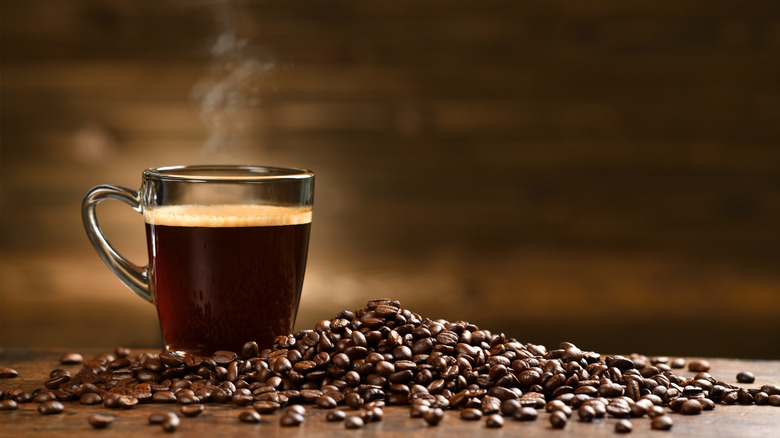Why Does French Roast Coffee Taste Smoky?
Here's a simple experiment: Examine a handful of French roast coffee beans alongside a pile of light- to medium-roast beans. The most obvious difference should be the color. French roast is a degree of dark roast. Therefore, these beans should be a deeper shade of brown than the others.
You may next notice the surface sheen. The longer and hotter coffee beans are roasted (which is what distinguishes a dark roast from lighter roasts), the more oils escape from the interior of the bean up to the surface. These oils coat the outside of dark roasts, giving them a glossy appearance.
But French roast coffee is not just any ol' dark roast. In general, coffee roasters heat their French roast batches to about 450-455 degrees Fahrenheit, whereas lighter dark roasts may be heated to 430-450 degrees. With all this heat, it's no surprise that smokiness is a major tasting note of darker roasts. The baristas at your local coffee shop will be eager to tell you about the natural flavors detectable in their lighter roasts. Ethiopian coffees, for example, may be reminiscent of berries or tea, depending on how the beans were processed prior to roasting. Other common flavor notes in coffee include citrus, chocolate, jasmine, tree nuts, and more. When it comes to dark roasts, the flavor profiles are more predictable. In addition to the smokiness, they are typically considered "bold," and you may identify notes of chocolate, caramel, and sometimes bitterness.
Getting into the science of it all
So, where there's fire, there's smokiness. But how does that work on a chemical level? It has to do with naturally occuring sugars in the beans caramelizing as they encounter the heat of a French roast. This caramelization can lead to some pleasant caramel notes in the French roast, producing what many consider a less bitter cup than other dark roasts.
Now, here's the big question: Do these bold-flavored dark roasts contain more caffeine than light roasts? Yes and no. Studies show that caffeine content is basically the same per bean regardless of roast level. However, when roasting to those darker levels, the cellular structures of the bean start breaking down, and moisture is lost. Another thing you might notice during your light vs. dark roast examination is that the darker beans are slightly larger — that's because this breakdown results in a larger, less dense bean. Due to their increased size, if you measure your coffee by the scoop, you'll use fewer dark roast beans per cup. You could therefore conclude that a cup of French roast coffee is less caffeinated. (Although that can be disputed.) If you measure your coffee by volume, you'll end up brewing more beans per cup because each bean weighs less. Result? More caffeine per sip.
Overall, the difference doesn't seem to be terribly significant. So choose your coffee based on your personal flavor preference, whether that's the smokiness of a French roast or the brighter complexity of a lighter roast. (And if you need help deciding, here's a guide to reading coffee labels.)

